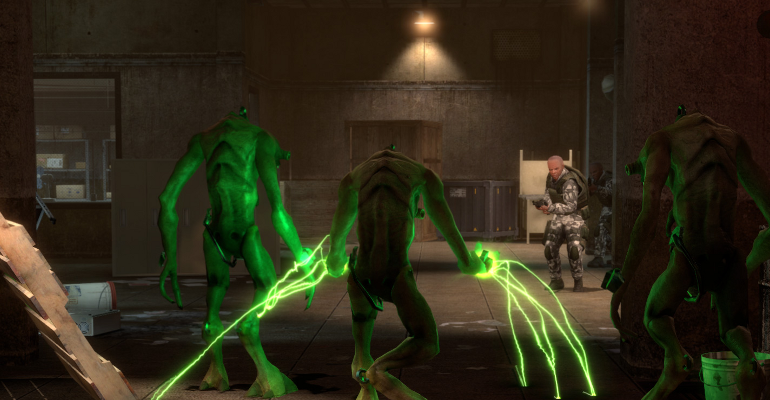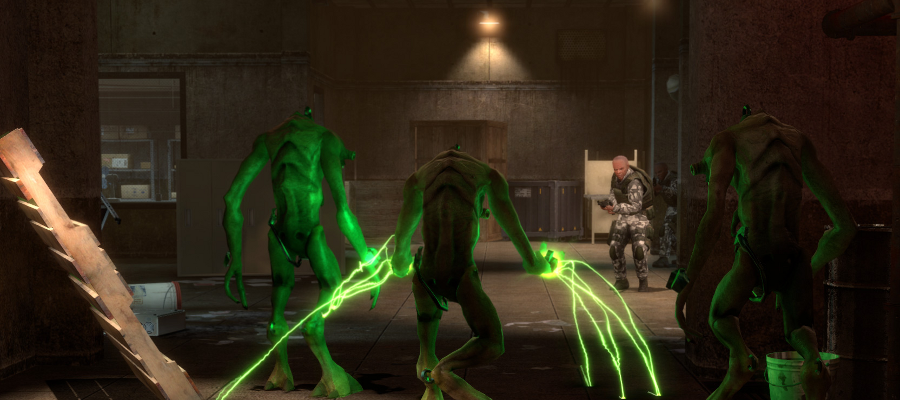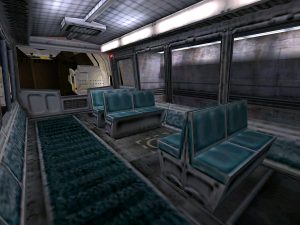Black Mesa: Renewing the Half-Life Vows
Half-Life is one of video games my top-tier games. The tier reserved for games who not only define what I want in gaming but push the boundaries on what this amazing hobby can do. When I heard that a team of Half-Life devotees had remade the original game using modern tools I was as skeptical as I was excited. While the trailers looked good, I couldn’t help but think that the remake named Black Mesa was going to be a disappointment. Who has the hubris to recreate such a classic? Does Black Mesa live up to the original?
The Time is 8:47 AM
While post this isn’t a review of Half-Life, some context would be useful.
In the ’90s the FPS genre was as much a pillar of PC gaming as the simulation and the strategy genre. But the FPS games of that era didn’t stray too far from the template that Wolfenstein 3D created in ’92. The focus was shooting bullets/plasma/magic at Nazis/aliens/demons and anything that could get in the way of shooting enemies was minimized to the point of being comical. Environments were abstract and bland (though Doom‘s lighting was a huge step forward), environmental hurdles were childish (opening doors with colored keys), and even travel time was nearly eliminated by making the average protagonist travel approximately 40mph on foot. They were simple games about blowing up anything that moved using ten weapons mapped to the number keys, and we loved every moment.
But Half-Life left this template behind in ’98. When Doom-bred FPS fans loaded up Half-Life, they didn’t get a gun for the first thirty minutes. Shit, they didn’t even leave a small train car for the first five and a half minutes. We entered the role of our silent protagonist Dr. Freeman as he commuted to work at the Black Mesa Research Facility. On a train. With absolutely nothing to do but soak in the scenery and listen to the droning PA system announce the temperature outside. Players saw the scorched desert that they’d later traverse, the bee-hive like offices that would soon be a battleground, machines trudging through green radioactive goo they’d later jump over. Sierra stripped gamers of their expectations in a five and a half minute long handshake with the game’s environment. Players had to wait and observe, they had no other option than to immerse themselves in Black Mesa. It was a meditation on being Dr. Freeman.
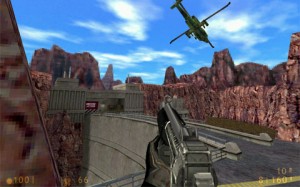 Half-Life was hailed as an “instant classic” because of the immersion that this deceptively ground-breaking train ride represents. Such a long establishing shot was unheard of in the decade’s previous PC FPS games. Black Mesa itself was as threatening and interesting as the things you were shooting. The puzzles made narrative sense, the hidden caches of supplies weren’t hidden behind walls that opened when you pressed the space bar, even the various hostile factions fought each other when they weren’t fighting you. Half-Life went to pains to make sure that the immersion was never broken, not even for a moment. It succeeded tremendously, and that’s why it’s hardly aged a day even 14 years later.
Half-Life was hailed as an “instant classic” because of the immersion that this deceptively ground-breaking train ride represents. Such a long establishing shot was unheard of in the decade’s previous PC FPS games. Black Mesa itself was as threatening and interesting as the things you were shooting. The puzzles made narrative sense, the hidden caches of supplies weren’t hidden behind walls that opened when you pressed the space bar, even the various hostile factions fought each other when they weren’t fighting you. Half-Life went to pains to make sure that the immersion was never broken, not even for a moment. It succeeded tremendously, and that’s why it’s hardly aged a day even 14 years later.
Hence my shock when I heard someone wanted to remake this game. Is that even possible?
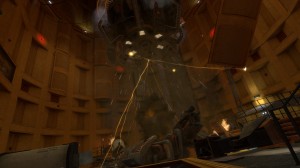 Limitless Potential
Limitless Potential
Black Mesa is a remake. It’s not a reboot, it’s not a spiritual successor; it is a remake. Remakes aren’t seen very often, and for good reason. Remakes promise something that reboots and successors don’t have to: they promise to capture the same spirit of the original work while using modern tools to do it. Every choice to remain true to the original risks alienating modern audiences and every implementation of modern design risks alienating nostalgic purists. Does Black Mesa succeed?
I answer that with a “mostly fuck yes!”
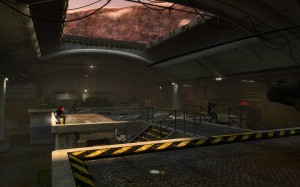 I’ll start with the bottom line: Black Mesa managed to make recreate that sense of frenetic crowbar swinging panic inside by chest as if I’d never felt it before. It was a true renewal of vows for Half-Life die hards like me. The game itself posed the same challenges that the original did, but with a gentle, loving touch that smoothed the whole experience over. The few weird, brutally unintuitive parts have been made clearer. A few of the jumping puzzles have been made a little less… awful. Effects and environments that were were impossible in ’98 were added to great effect. Add to this a professional level of polish and you have a remastered edition of Half-Life that remains true to the original while being cleverly designed.
I’ll start with the bottom line: Black Mesa managed to make recreate that sense of frenetic crowbar swinging panic inside by chest as if I’d never felt it before. It was a true renewal of vows for Half-Life die hards like me. The game itself posed the same challenges that the original did, but with a gentle, loving touch that smoothed the whole experience over. The few weird, brutally unintuitive parts have been made clearer. A few of the jumping puzzles have been made a little less… awful. Effects and environments that were were impossible in ’98 were added to great effect. Add to this a professional level of polish and you have a remastered edition of Half-Life that remains true to the original while being cleverly designed.
The iconic train ride is a perfect example of Black Mesa’s mastery. The train ride hits all of the same notes and shows you all of the iconic sights you remember. But it adds where it needs to, foreshadows more where it’s appropriate, and makes it all down right gorgeous. But the train ride is still five and a half fucking minutes long. The Black Mesa team knew the importance of that train ride, knew the importance of meditating on being Dr. Freeman, and just made the whole experience better.
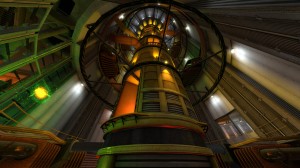 It’s not perfect, of course. The game adopts just enough of the modern FPS philosophy to mildly frustrate. Black Mesa doesn’t have the same faith in the player that Half-Life did. For example, the simplification of the Power Up and On a Rail chapters prevented me from seeing the Marines and aliens fighting it out while I wasn’t their primary target, taking away a key moment that clearly illustrates that the player is just a piece of a bigger picture. The Surface Tension chapter was also made more clear with the exploration elements removed, taking away the visceral “sneaking on your belly around Marines” gameplay the original had. Black Mesa ultimately doesn’t demonstrate the same moxy that the original does. But honestly, this is hardly criticism, I can’t help but suspect that this is my own unyielding nostalgia spoiling my own fun. So have this grain of salt, on me.
It’s not perfect, of course. The game adopts just enough of the modern FPS philosophy to mildly frustrate. Black Mesa doesn’t have the same faith in the player that Half-Life did. For example, the simplification of the Power Up and On a Rail chapters prevented me from seeing the Marines and aliens fighting it out while I wasn’t their primary target, taking away a key moment that clearly illustrates that the player is just a piece of a bigger picture. The Surface Tension chapter was also made more clear with the exploration elements removed, taking away the visceral “sneaking on your belly around Marines” gameplay the original had. Black Mesa ultimately doesn’t demonstrate the same moxy that the original does. But honestly, this is hardly criticism, I can’t help but suspect that this is my own unyielding nostalgia spoiling my own fun. So have this grain of salt, on me.
It’s also worth mentioning that the game isn’t finished yet. What is there is done, certainly, but the game ends before the last pivotal chapter begins. A complete game is promised sometime over the horizon, which I’m eagerly waiting for.
It’s Time to Choose
Actually, no, there’s no choice. Black Mesa is free. Download the Source 2007 engine from Steam and you have all you need to play it. As I told my best friend, Black Mesa “let me play Half-Life for the first time all over again”. I don’t know if there’s any higher praise for a remake. Any meager criticism I could find against Black Mesa is dwarfed by how well it retains the intent of the original while making a fun, fresh game.

